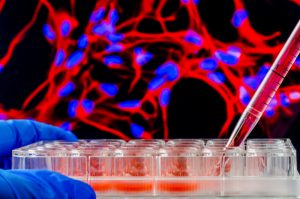
The molecules designed are the smallest reported photosensitizers (PS) to date, offering a minimally invasive precise approach to photodynamic therapy (PDT) with high sensitivity and selectivity.
Its compatibility with a wide range of biomolecules provides an opportunity to use it as a PS tailored to targeting various types of diseases – from infections to tumours.
Application
This photosensitizer can be used in photodynamic therapy to target diseased cells with high precision.
Development Status
Preliminary data on use for cancer and antimicrobial PDT with good safety profiles.
IP Status
Commercial Offerings
Opportunity
The designed small molecule - benzoselenadiazole - is a photosensitizer (PS) with great potential as a novel photodynamic therapy (PDT). Unlike other bulkier fluorophores in the market which frequently target healthy surrounding cells, this PS has been designed to be remarkably small and non-charged, enabling more efficient incorporation into diseased cells.
The PS can be coupled to several biomolecules, ranging from small molecules to peptides or antibodies, making it a versatile PDT that can be tailored to precisely target your disease of interest – from infected cells to microtumours.
Technology
Benzoselenadiazole is the smallest reported photosensitizer (PS) designed to date. The small size of molecule causes the PS to mimic native biomolecules, recapitulating highly efficient uptake into cells with altered metabolic signatures reflective of disease.
Upon targeted exposure to non-toxic light, the highly sensitive and selective uptake of this PS enables its utility as a photodynamic therapy (PDT) to precisely target disease-causing cells even at early stages of metabolic dysfunction, while sparing healthy cells to minimize unwanted off-target effects.
Benefits
Publications
Benson, S., de Moliner, F., Fernandez, A. et al. Photoactivatable metabolic warheads enable precise and safe ablation of target cells in vivo. Nat Commun 12, 2369 (2021). https://doi.org/10.1038/s41467-021-22578-2
Benson, S., Kiang, A., Lochenie, C., Lal, N., Mohanan, S.M.P.C., Williams, G.O.S., Dhaliwal, K., Mills, B., Vendrell, M. (2023). Environmentally sensitive photosensitizers enable targeted photodynamic ablation of Gram-positive antibiotic-resistant bacteria. Theranostics, 13(11), 3814-3825. https://doi.org/10.7150/thno.84187
Quote: TEC1104067

Senior Technology Transfer Executive
College of Science and Engineering
College of Medicine and Veterinary Medicine